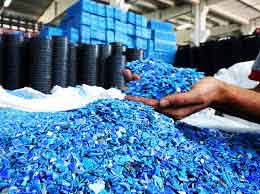Recycling Plastic - Facts You Need to Know
If you have heard about the Plastic Continent -- the floating island of plastic twice the size of Texas in the Pacific Ocean -- then you understand how crucial it is to recycle plastic. Right now, only 5% of plastics worldwide are recycled. Some of this is ignorance: most of the world still simply doesn't understand the danger plastics pose to our environment and our food chain.
But plastics themselves are complicated. Even if you want to recycle your plastics, and even if you dutifully separate plastics from the rest of your household waste and put it out on the curb in its blue or green recycle bin, your plastics might still end up in the Plastic Continent. Why is this?
Different Types of Plastic
Look at the underneath side of a plastic bottle or plastic container. Inside the familiar reduce, reuse, recycle triangle ("chasing arrows") logo is a number between one and seven. This number indicates what kind of plastic that container is made from. Some plastics are easy to recycle, but other plastics are much harder to recycle. As a result, most municipal recycling facilities only recycle the easiest plastics: plastics 1 and 2. What happens to plastics 3 through 7? At some recycling facilities, these are gathered until they have enough to send to a larger recycling facility that does recycle these types of plastics. But at other recycling facilities, the same thing happens to plastics 3 through 7 as what would have happened at your house if you didn't have that handy recycling bin: it goes to the landfill, or the Pacific's Plastic Continent.
Plastics #1 and #2
Plastic #1 is polyethelyne terephthalate (PET). This is the most commonly used plastic, and it's the easiest to recycle. Your plastic soda bottle, salad dressing bottle, and cooking oil bottle are probably all made from PET. More than 2.3 billion pounds of PET are recycled annually.
Plastic #2 is high density polyethelene (HDPE). Most milk jugs, detergent bottles, and many food containers are made from HDPE. Unfortunately, some plastics marked with a #2, such as yogurt cups, are not actually recyclable. This is because other chemicals have been added to the plastic in order to mold it into the desired shape. These additives make recycling some of these #2 items basically impossible.
Plastics #1 and #2 make up 96% of all the plastic bottles produced in the United States. Nevertheless, 80% of plastic bottles still wind up in a landfill, even though 80% of Americans have access to a method for recycling these bottles.
Plastic #3 through #7
The rest of the plastics make up pretty much everything that's not a plastic bottle. Just think of all the plastics in your home -- your toothbrush, cling wrap, plastic bowls, plastic cups, drinking straws, last night's leftovers, that almost-impossible-to-open package your new iPhone came in, your computer, your DVD cases... plastic is everywhere.
These plastics can all be categorized as the plastics #3 through #7. None of them are particularly easy to recycle, so even though your recycling guy will take it from your curb, that doesn't necessarily mean it will become tomorrow's soda bottle. However, by researching recycling facilities in your area, you can find places to recycle these less common plastics.
The Bottom Line When it Comes to Plastic Recycling
Plastic is much harder to recycle than other materials. Because it breaks down during the recycling process, it can only be recycled so many times -- this is why many recyclers prefer so-called "virgin plastics", or plastics that haven't been recycled before because they make a better product. That means that even if you do the best you can to recycle all your plastics, some of them might still wind up in the dump.
The clear conclusion we must draw is that even the most conscientious recycling is not enough when it comes to plastics: ultimately, we have to reduce our consumption. The process of producing plastics, many plastics themselves, and the aftermath of plastic use can all be described as toxic. Nearly all manufacturing processes for the different types of plastic listed above involve some degree of toxicity, and as these plastics disintegrate in landfills or in the ocean, these toxic chemicals find their ways back into our soils, our water, our food, and our bodies.
So please, recycle your plastics.
Article Source: http://EzineArticles.com/2900461


Comments